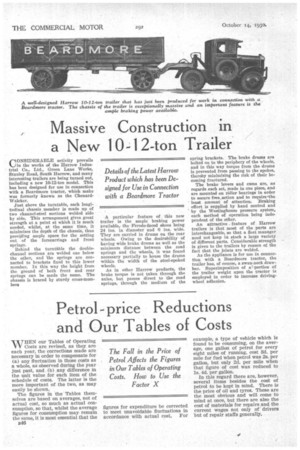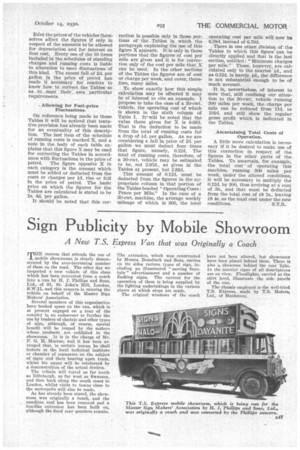Petrol-price Reductions and Our Tables of Costs
Page 72

Page 73

If you've noticed an error in this article please click here to report it so we can fix it.
WHEN our Tables of Operating Costs are revised, as they are each year, the corrections made are necessary in order to compensate for (a) any fluctuation in those costs as a whole, as observed during the year just past, and (b) any difference in the unit value for each item of the schedule of costs. The latter is the more important of the two, as may easily be shown.
The figures in the Tables themselves are based on averages, not of actual cost, so much as actual consumption, so that, whilst the average figures for consumption may remain the same, it is most essential that the figures for expenditure be corrected to meet unavoidable fluctuations in accOrdance with actual cost. For example, a type of vehicle which is found to be consuming, on the average, one gallon of petrol for every eight miles of running, cost 8d. per mile for fuel when petrol was 2s. per gallon, but only 2d. per mile when that figure of cost was reduced to is. 4d. per gallon.
In this regard there are, however, several items besides the cost of petrol to be kept in mind. There is the price of oil and tyres. These are the most obvious and will come to mind at once, but there are also the cost of materials for repairs and the current wages not only of drivers but of repair staffs generally.
E'en the prices of the vehicles themselves affect the figures if only in respect of the amounts to be allowed for depreciation and for interest on first cost. Every one of the 10 items included in the schedules of standing charges and running costs is liable to alteration to meet .fluetuations'of this kind. The recent fall. of 2d. per .gallon, in the price of petrol has made it necessary " forreaders tO know how to correct the Tables so as ...to_ meet _ their„. own _ particular requirements.
• Allowing. for Fuel-price Fluctuations.
On reference being made to those Tables it will be noticed that tentative provision has already been made for an eventuality of this description. • The last item of the schedule of running costs is marked X, and a note in the body of each table explains that this figure X may be used for correcting the Tables in accordance with fluctuations in the price of petrol. The figure opposite X in each category is the amount which must be added or deducted from the costs or charges per id. rise or fall In the price of petrol. The basic price on which the figures for the Tables are calculated is stated to be Is. 4d. per gallon.
It should be noted that this cor
rection is possible only in those pot.... tions of the Tables in which the paragraph explaining the use of this figure X appears. It is only in these portions that the figures of cost per mile are given and it is for correction only of the -cost per mile -that X can be used. In the other seething of the Tables the figures are of cost or charge per week, and cover, therefore, many miles.
To show exactly how this simple calculation may be effected it may be of interest to cite an example. propose to take the case of a 30-cwt. vehicle, the operating cost of which is shown in the sixth column of Table I. it' will be noted that the value there given for X is 0.03d. That is the deduction to be made from the total of running costs for a drop of id. per gallon. As we are considering a fall in price of 2d. per gallon we must deduct four times that figure, namely, 0.12d. The total of running costs, therefore, of a 30-cwt. vehicle may be estimated to be, ,not 2.95d., as given hi the Tables at present, but 2.83d.
This amount of 0.12d. must be deducted from the figures in the appropriate column in that portion of the Tables headed "Operating Costs : Pence per Mile." In the case of a 30-cwt. machine, the average weekly mileage of which is 300, the total
operating_ cost per mile will now be 6.58d. instead of 6.70d.
There as one other division of the Tables to which this figure' can be directly apPlied and that is the last section, entitled : "Minimum charges per mile." These, however, are calculated only to the nearest id., and as 0.12d. is barely id., the difference is not substantial enough to be of much account.
It is, nevertheless, of interest to note that, still confining our attention to the 30-cwt. vehicle running 300 miles per week, the charge per Mile can be reduced from 11d. to 10id, and still show the regular gross profit which is indicated in the Tables.
Ascertaining Total Costs of Operation.
A little more calculation is necessary if it be desired to make use of this correction in resnect of the figures in the other parts of the Tables. To ascertain, for example, the total cost of operating this machine, running 300 miles per week, under the altered conditions, it will be necesSary to multiply the 0.12d. by 300, thus arriving at a sum of 3s., and that must be deducted from the total cost of £8 'Ts., leaving £8 4s. as the total cost under the new
conditions. S.T.R.




















































































































